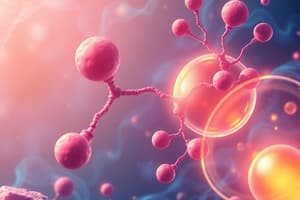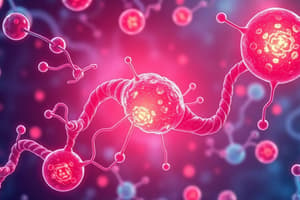Podcast
Questions and Answers
What is the minimum daily protein intake required for a 70 kg adult to replace lost protein assuming complete utilization?
What is the minimum daily protein intake required for a 70 kg adult to replace lost protein assuming complete utilization?
- 34 g (correct)
- 30 g
- 40 g
- 24 g
What percentage of protein is nitrogen by weight?
What percentage of protein is nitrogen by weight?
- 16 % (correct)
- 12 %
- 18 %
- 10 %
Which protein has the highest biological value according to the provided content?
Which protein has the highest biological value according to the provided content?
- Egg (correct)
- Beef
- Casein
- Soy
What is the total daily nitrogen loss for an adult with a body weight of 70 kg?
What is the total daily nitrogen loss for an adult with a body weight of 70 kg?
What is the chemical score of beef as expressed in the content?
What is the chemical score of beef as expressed in the content?
What is the primary role of glutamate in the metabolism described?
What is the primary role of glutamate in the metabolism described?
Which component enters the urea cycle directly from the mitochondria?
Which component enters the urea cycle directly from the mitochondria?
What happens to NH3 in the liver?
What happens to NH3 in the liver?
How does metabolic acidosis affect NH4+ excretion?
How does metabolic acidosis affect NH4+ excretion?
What is the consequence of high protein, energy-poor diets on urea production?
What is the consequence of high protein, energy-poor diets on urea production?
What type of regulation primarily affects CPS I in the urea cycle short term?
What type of regulation primarily affects CPS I in the urea cycle short term?
In which location does the urea cycle primarily take place?
In which location does the urea cycle primarily take place?
Which metabolic pathway is linked with the transfer of excess NH3 to pyruvate?
Which metabolic pathway is linked with the transfer of excess NH3 to pyruvate?
What is the primary effect of the urea cycle on energy production?
What is the primary effect of the urea cycle on energy production?
Under which condition does amino acid oxidation primarily occur?
Under which condition does amino acid oxidation primarily occur?
What happens to the carbon skeleton of amino acids during catabolism?
What happens to the carbon skeleton of amino acids during catabolism?
Which of the following products is generated directly from the oxidation of α-keto acids?
Which of the following products is generated directly from the oxidation of α-keto acids?
How many catabolic pathways of amino acids converge to form products that enter the citric acid cycle?
How many catabolic pathways of amino acids converge to form products that enter the citric acid cycle?
Which amino acid is classified as essential in young and growing individuals?
Which amino acid is classified as essential in young and growing individuals?
What does a positive nitrogen balance indicate?
What does a positive nitrogen balance indicate?
Which of the following enzymes has a high Km and low affinity for amino acids?
Which of the following enzymes has a high Km and low affinity for amino acids?
Under which condition would you expect significant oxidation of amino acids to occur?
Under which condition would you expect significant oxidation of amino acids to occur?
What is true about transamination reactions?
What is true about transamination reactions?
What role does vitamin B6 (pyridoxine) play in amino acid metabolism?
What role does vitamin B6 (pyridoxine) play in amino acid metabolism?
Which amino acids are primarily involved in amino group transfer during transamination reactions?
Which amino acids are primarily involved in amino group transfer during transamination reactions?
What happens to ammonia (NH3) that is produced from amino acid catabolism in the liver?
What happens to ammonia (NH3) that is produced from amino acid catabolism in the liver?
Which amino acids are classified as glucogenic?
Which amino acids are classified as glucogenic?
What is the primary function of biotin in amino acid metabolism?
What is the primary function of biotin in amino acid metabolism?
Which enzyme is associated with the conversion of pyruvate into oxaloacetate using biotin?
Which enzyme is associated with the conversion of pyruvate into oxaloacetate using biotin?
Which of the following correctly describes tetrahydrofolate's role in one-carbon unit transfer?
Which of the following correctly describes tetrahydrofolate's role in one-carbon unit transfer?
Which essential amino acid is categorized as ketogenic?
Which essential amino acid is categorized as ketogenic?
Which of the following forms of one-C units is the most oxidized?
Which of the following forms of one-C units is the most oxidized?
What is the relationship between THF and methyl group transfer in mammals?
What is the relationship between THF and methyl group transfer in mammals?
Which amino acid is NOT synthesized from amphibolic intermediates in higher animals?
Which amino acid is NOT synthesized from amphibolic intermediates in higher animals?
Which enzyme requirement characterizes the synthesis of non-essential amino acids compared to essential ones?
Which enzyme requirement characterizes the synthesis of non-essential amino acids compared to essential ones?
Which of the following metabolic disorders is associated with amino acid catabolism anomalies?
Which of the following metabolic disorders is associated with amino acid catabolism anomalies?
Flashcards
Daily Nitrogen Loss
Daily Nitrogen Loss
The amount of nitrogen lost from the body daily. This is typically 30-40 grams per day.
Protein Replacement
Protein Replacement
The minimum amount of protein needed to replace the nitrogen lost. This depends on body size.
Biological Value (BV)
Biological Value (BV)
A measure of a protein's nutritional value, based on how much nitrogen is retained by the body relative to intake.
Essential Amino Acids
Essential Amino Acids
Signup and view all the flashcards
Chemical Score
Chemical Score
Signup and view all the flashcards
Positive Nitrogen Balance
Positive Nitrogen Balance
Signup and view all the flashcards
Negative Nitrogen Balance
Negative Nitrogen Balance
Signup and view all the flashcards
Nitrogen Equilibrium
Nitrogen Equilibrium
Signup and view all the flashcards
Transamination
Transamination
Signup and view all the flashcards
Amino Acid Catabolism
Amino Acid Catabolism
Signup and view all the flashcards
Transaminases
Transaminases
Signup and view all the flashcards
Amino Acid Oxidation
Amino Acid Oxidation
Signup and view all the flashcards
Urea Cycle Energy
Urea Cycle Energy
Signup and view all the flashcards
Amino Acid Degradation: When?
Amino Acid Degradation: When?
Signup and view all the flashcards
Amino Acid Oxidation: What Happens?
Amino Acid Oxidation: What Happens?
Signup and view all the flashcards
Carbon Skeleton and The Citric Acid Cycle:
Carbon Skeleton and The Citric Acid Cycle:
Signup and view all the flashcards
Carbon Skeleton Destinations:
Carbon Skeleton Destinations:
Signup and view all the flashcards
Glutamate's role in NH4+ formation
Glutamate's role in NH4+ formation
Signup and view all the flashcards
What happens to excess NH3 in muscle?
What happens to excess NH3 in muscle?
Signup and view all the flashcards
Where does NH3 go in the body?
Where does NH3 go in the body?
Signup and view all the flashcards
How does NH4+ form salts?
How does NH4+ form salts?
Signup and view all the flashcards
Urea Cycle location
Urea Cycle location
Signup and view all the flashcards
What is the Aspartate-Argininosuccinate Shunt?
What is the Aspartate-Argininosuccinate Shunt?
Signup and view all the flashcards
How is the Urea Cycle regulated?
How is the Urea Cycle regulated?
Signup and view all the flashcards
How is urea cycle regulated in short term?
How is urea cycle regulated in short term?
Signup and view all the flashcards
Glucogenic Amino Acids
Glucogenic Amino Acids
Signup and view all the flashcards
Ketogenic Amino Acids
Ketogenic Amino Acids
Signup and view all the flashcards
Pyridoxine (Vitamin B6)
Pyridoxine (Vitamin B6)
Signup and view all the flashcards
THF's role in 1-C unit transfer
THF's role in 1-C unit transfer
Signup and view all the flashcards
THF's most reduced form?
THF's most reduced form?
Signup and view all the flashcards
Major source of 1-C units for THF?
Major source of 1-C units for THF?
Signup and view all the flashcards
Why isn't THF preferred for methyl group transfers?
Why isn't THF preferred for methyl group transfers?
Signup and view all the flashcards
What are the preferred cofactors for methyl group transfers?
What are the preferred cofactors for methyl group transfers?
Signup and view all the flashcards
Study Notes
Proteins in the Diet and Nitrogen Metabolism
- Dietary protein intake was once believed to lead to greater muscle deposition and strength, but current understanding suggests adequate protein intake alone is sufficient for health. Excess intake is potentially unhealthy.
- Protein turnover is a constant process, involving synthesis and degradation of body protein (1-2% daily).
- Protein excretion is unavoidable, even without dietary protein.
- Excess amino acids are metabolized and excreted when protein intake is high.
- The rate of protein synthesis and degradation varies depending on physiological demands and the protein type. Half-lives of proteins range from 30 seconds to many days.
- 75-80% of liberated amino acids are reutilized for new protein synthesis, while the remainder becomes urea and is used in other metabolic processes.
- Daily nitrogen loss is approximately 30-40 grams or 5-7 grams of nitrogen.
- A 70 kg adult loses about 24 grams daily protein.
- Adequate daily protein intake for a 70 kg adult should be 34 grams (assuming 70% utilization),
- Foods vary in their protein content, with some being rich in protein and others being poor.
- Biological value assesses protein value based on net protein content of available nitrogen and excreted nitrogen. Higher values mean better utilization.
- Chemical score measures essential amino acids ratio to an ideal protein.
- Essential amino acids include: Arginine*, Histidine*, Isoleucine, Leucine, Lysine, and Valine. * denotes semi-essential or essential only in young individuals or developing individuals.
- Positive nitrogen balance occurs when nitrogen intake exceeds excretion; this indicates tissue growth or repair.
- Negative nitrogen balance occurs when nitrogen excretion exceeds intake; this indicates tissue breakdown or loss.
- High protein intake can induce protein catabolizing enzymes in the liver, and amino acids are metabolized when carbohydrates are unavailable (starvation or diabetes).
- Separate amino groups are removed from amino acids.
- Most amino acids are metabolized in the liver.
- Several pathways and reactions occur in amino acid catabolism, including transamination, oxidative deamination, and urea synthesis.
Nitrogen is Important
- Only a few microorganisms incorporate N₂ into organic molecules.
- NH₃ is toxic to the nervous system.
- Many plants can incorporate NH₃ into their structures.
Paths and Reactions in Amino Acid Catabolism
- Most amino acids are metabolized in the liver.
- Some NH₃ is used; the rest is excreted.
- NH₃ from other tissues is transported to the liver.
- Important reactions are transamination, oxidative deamination, & urea synthesis.
Protein Turnover
- Dietary proteins are broken down into amino acids that enter the blood.
- Amino acids are used for synthesis of various compounds or tissue in the body.
- Excess amino acid is excreted as urea.
- All proteins are synthesized and degraded constantly in the body.
Rate of Synthesis and Degradation
- Protein turnover involves constantly degrading and synthesizing proteins in the body.
- 1-2% of the body's protein is degraded daily.
- Protein degradation and synthesis rates vary between proteins in the body.
- The rates can change based on the body's needs or demands.
Replacing the Lost Amount
- Proteins contain 16% nitrogen by weight.
- Daily nitrogen loss can be determined by multiplying total body nitrogen by 6.25 to calculate the total body protein.
Quality of Protein
- Proteins are measured by biological value.
- Chemical score measures essential amino acids.
Essential Amino Acids
- Essential amino acids are broken down in the body and the carbon skeleton is either used for gluconeogenesis or ketogenesis, or used as oxidized as CO2 and H2O.
Evaluation of Protein Nutrition
- Positive nitrogen balance: nitrogen intake is greater than excretion (indicates growth, repair).
- Negative nitrogen balance: nitrogen excretion is greater than intake (indicates breakdown, loss).
Effects of Dietary Intake
- High intake induces protein-catabolizing enzymes in the liver.
- Amino acid catabolizing enzymes have a high Km and low affinity.
Oxidation of Amino Acids
- During normal protein turnover or a protein-rich diet, excess amino acids are catabolized and excreted.
- Oxidized when carbohydrates are unavailable (starvation or diabetes).
Urea Cycle
- The nitrogen is removed and combined with carbon dioxide to produce urea which is excreted from the body.
- This cycle occurs in the liver.
Glutamate Channels NH₃ Flow
- In the liver, NH₃ is converted to glutamate.
- Glutamate carries the amino group to the mitochondria, where it's removed.
- Excess NH₃ in muscle is converted to alanine.
Oxidative Deamination
- Conversion of glutamate to a-ketoglutarate, releasing ammonia.
- Oxidative deamination is catalyzed by glutamate dehydrogenase in the mitochondria.
Fates of NH₃
- NH₃ is converted to urea in the liver.
- NH₃ can be used for synthesis of other molecules, such as amino acids.
Glucose Alanine Cycle
- The cycle exchanges amino groups between the liver and the muscles.
Amino Acid Oxidation and the Catabolism of the Carbon Skeleton of Amino Acids
- During protein degradation and a high protein diet, amino acids oxidize.
- Excess amino acids provide carbon skeletons for the synthesis of other molecules. -Some amino acids are oxidized to CO2 and H20.
Amino Acid Oxidation
- During normal protein turnover, amino acids oxidize to generate energy and other molecules.
- A high protein diet can lead to amino acid oxidation.
- Starvation can also cause amino acid oxidation.
Amino Acid Oxidation
- Amino acids lose their amino groups to form a-keto acids.
- The a-keto acids are oxidized to produce carbon dioxide and water or converted into other molecules.
Amino Acids and Their Carbon Skeletons
- Amino acids lose their amino groups and form a-keto acids.
- The a-keto acids are oxidized to create carbon dioxide and water, used for the synthesis of other molecules.
The Catabolism of the Carbon Skeleton of Amino Acids
- The carbon skeletons of amino acids are further metabolized through several pathways including gluconeogenesis, ketogenesis, or complete oxidation to CO2 and H2O.
Glucogenic and Ketogenic Amino Acids
- Some amino acids can be converted to glucose, whereas others are converted into ketone bodies.
Enzyme Cofactors
- PLP is used in transamination reactions.
- Biotin transfers carbon units.
- Tetrahydrofolate transfers intermediate carbon units.
Pyridoxine (Vit B6)
- Pyridoxal phosphate (PLP) is a coenzyme important in amino acid metabolism.
Biotin
- Biotin is a coenzyme for carboxylation reactions and transfers one-carbon units (CO2)
Role of Folic Acid in Amino Acid Metabolism
- Folic acid is important for transferring one-carbon units in different oxidation states.
- THF acts as a carrier for several oxidation states for one-carbon units.
- Folic acid is important in the transfer of methyl groups.
p-Aminobenzoate
- p-Aminobenzoate is a compound used to produce some amino acids.
Methionine
- Methionine is an essential amino acid and important for the transfer of methyl groups in several biological processes.
Pyruvate Carboxylase
- The enzyme catalyzes the carboxylation of pyruvate to oxaloacetate, a reaction important in gluconeogenesis.
Role of Folic Acid and Amino Acid Metabolism
- Single-carbon atoms can exist in varied oxidation states and can be incorporated into various molecules.
- Tetrahydrofolate (THF) carries these carbon molecules.
Other Amino Acid Pathways
- Various amino acids are catabolized through specific pathways, which vary greatly, and can form the carbon skeletons for gluconeogenesis, ketogenesis, or complete oxidation to CO2 and H2O.
Genetic Disorders of Amino Acid Catabolism
- Several genetic disorders result from deficiencies or mutations in enzymes involved in amino acid breakdown.
Biosynthesis of Amino Acids
- Higher animals have lost the ability to synthesize some amino acids.
- Biosynthesis of amino acids frequently occurs through short pathways from amphibolic intermediates.
Number of Enzymes Required for Synthesis
- The number of enzymes required for the synthesis of essential and nonessential amino acids differs.
Problems with Amino Acid Catabolism
- Various problems can arise from impaired pathways, and the diseases are specific to affected pathways and can have varied symptoms and impacts
Tyrosinemia
- Defective tyrosine degradation pathways can create an excess of tyrosine or its byproducts
- These compounds can lead to disease and health problems.
Maple Syrup Urine Disease
- Branched-chain a-keto acids accumulate in the blood. This condition is caused by the deficiency of an enzyme, and it leads to the toxic accumulation of these acids, which causes adverse effects on the body. The symptoms include mental retardation, vomiting, and convulsions.
Phenylketonuria
- Defect in phenylalanine hydroxylase, the enzyme that converts phenylalanine to tyrosine.
- Phenylalanine accumulates, leading to intellectual disability and other adverse effects.
(Additional notes on Urea Cycle and other pathways):
-
Multiple enzymatic pathways contribute to the process.
-
Regulations and pathways can affect production and activity.
(Additional notes on various disorders in Amino Acid Catabolism):
-
This involves specific defective steps of breakdown.
-
The genetic disorders are usually caused by enzyme deficiencies, which can cause toxic compounds to accumulate in the body and present as various symptoms leading to potentially severe health issues.
Studying That Suits You
Use AI to generate personalized quizzes and flashcards to suit your learning preferences.



